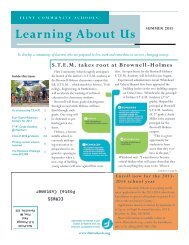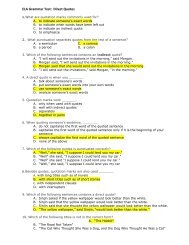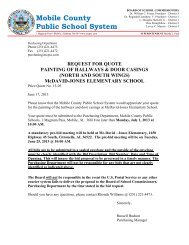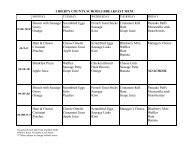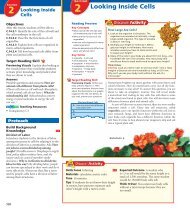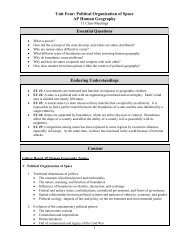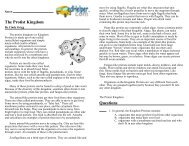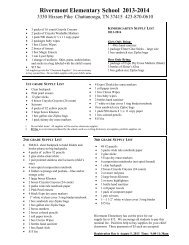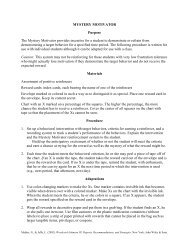Chapter 12: America and World War II, 1941-1945 - Georgia ...
Chapter 12: America and World War II, 1941-1945 - Georgia ...
Chapter 12: America and World War II, 1941-1945 - Georgia ...
You also want an ePaper? Increase the reach of your titles
YUMPU automatically turns print PDFs into web optimized ePapers that Google loves.
They’d halt us in front of these big artesian<br />
“<br />
wells . . . so we could see the water <strong>and</strong> they wouldn’t<br />
let us have any. Anyone who would make a break for<br />
water would be shot or bayoneted. Then they were<br />
left there. Finally, it got so bad further along the road<br />
that you never got away from the stench of death.<br />
There were bodies laying all along the road in various<br />
degrees of decomposition—swollen, burst open, maggots<br />
crawling by the thous<strong>and</strong>s. . . .<br />
”<br />
—quoted in Death March: The Survivors of Bataan<br />
Although the troops in the Bataan Peninsula surrendered,<br />
a small force held out on the isl<strong>and</strong> of<br />
Corregidor in Manila Bay. Finally, in May 1942,<br />
Corregidor surrendered. The Philippines had fallen.<br />
The Doolittle Raid Even before the fall of the<br />
Philippines, President Roosevelt was searching for a<br />
way to raise the morale of the <strong>America</strong>n people. He<br />
wanted to bomb Tokyo, but <strong>America</strong>n planes could<br />
reach Tokyo only if an aircraft carrier brought them<br />
close enough. Unfortunately, Japanese ships in the<br />
North Pacific prevented carriers from getting close<br />
enough to Japan to launch their short-range bombers.<br />
In early 1942, a military planner suggested replacing<br />
the carrier’s usual short-range bombers with<br />
long-range B-25 bombers that could attack from farther<br />
away. Although B-25s could take off from a carrier,<br />
they could not l<strong>and</strong> on its short deck. After<br />
attacking Japan, they would have to l<strong>and</strong> in China.<br />
President Roosevelt put Lieutenant Colonel<br />
James Doolittle in comm<strong>and</strong> of the mission. At the<br />
end of March, a crane loaded sixteen B-25s onto the<br />
aircraft carrier Hornet. The next day the Hornet<br />
headed west across the Pacific. On April 18,<br />
<strong>America</strong>n bombs fell on Japan for the first time.<br />
A Change in Japanese Strategy While <strong>America</strong>ns<br />
were overjoyed that the air force had finally struck<br />
back, Japanese leaders were aghast. Doolittle’s bombs<br />
could have killed the emperor. The Doolittle raid<br />
convinced Japanese leaders to change their strategy.<br />
Before the raid, the Japanese Navy had been arguing<br />
about what to do next. The officers in charge of<br />
the navy’s planning wanted to cut <strong>America</strong>n supply<br />
lines to Australia by capturing the south coast of<br />
New Guinea. The comm<strong>and</strong>er of the fleet, Admiral<br />
Yamamoto, wanted to attack Midway Isl<strong>and</strong>—the<br />
last <strong>America</strong>n base in the North Pacific west of<br />
Hawaii. Yamamoto believed that attacking Midway<br />
would lure the <strong>America</strong>n fleet into battle <strong>and</strong> enable<br />
his fleet to destroy it.<br />
After Doolittle’s raid, the planners dropped their<br />
opposition to Yamamoto’s plan. The <strong>America</strong>n fleet<br />
had to be destroyed in order to protect Tokyo from<br />
bombing. The attack on New Guinea would still go<br />
ahead, but only three aircraft carriers were assigned<br />
to the mission. All of the other carriers were ordered<br />
to prepare for an assault on Midway.<br />
The Battle of the Coral Sea The Japanese<br />
believed that they could proceed with two different<br />
attacks. They thought the United States was<br />
unaware of Japan’s activity <strong>and</strong> would not be able to<br />
respond in time. Japan did not know that an<br />
<strong>America</strong>n team of code breakers, based in Hawaii,<br />
had already broken the Japanese Navy’s secret<br />
code for conducting operations.<br />
Striking Back: The Doolittle Raid, April 18, 1942<br />
The plan for the Doolittle raid was to launch B-25<br />
bombers from aircraft carriers between 450 <strong>and</strong> 650 miles<br />
from Japan. The planes would bomb selected targets, <strong>and</strong><br />
fly another 1,200 miles to airfields in China.<br />
All went well until the Japanese discovered the<br />
carriers more than 150 miles from the proposed launch<br />
site. Instead of canceling the mission, the bombers took<br />
off early. The planes reached Japan <strong>and</strong><br />
dropped their bombs, but they did not have<br />
enough fuel to reach the friendly airfields in<br />
China. The crews were forced to bail out or<br />
crash-l<strong>and</strong>, <strong>and</strong> only 71 of the 80 crew<br />
members survived. Nevertheless, the raid<br />
provided an instant boost to sagging<br />
<strong>America</strong>n morale.<br />
Planes arrive<br />
in China<br />
Tokyo is<br />
bombed<br />
Carriers launch B-25s



